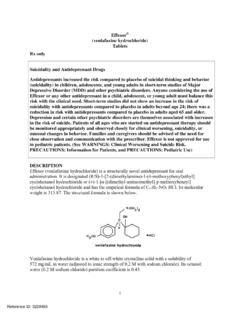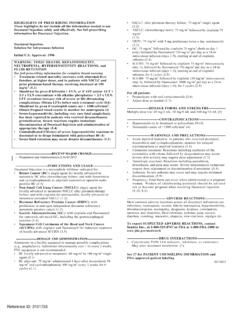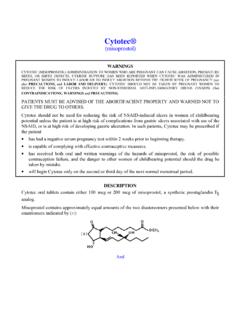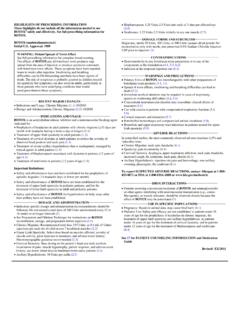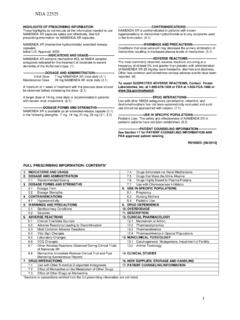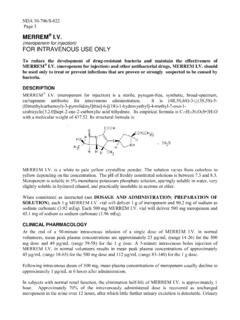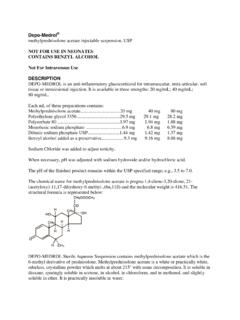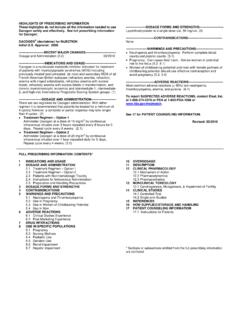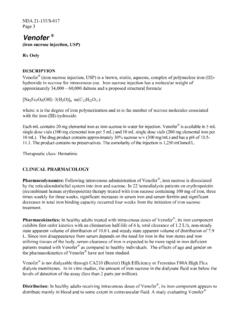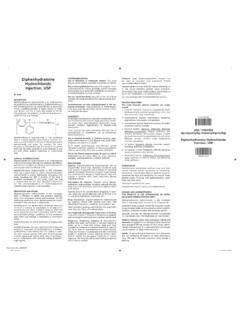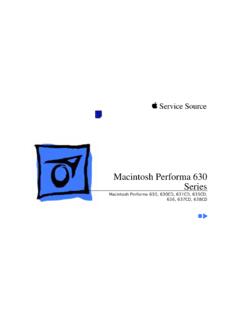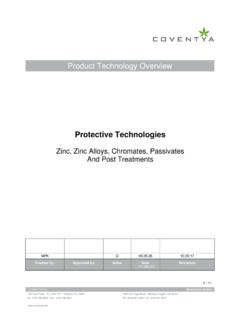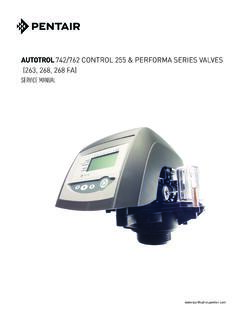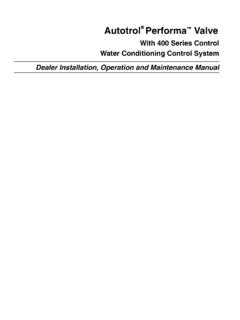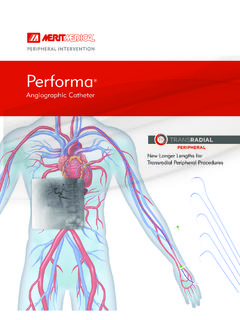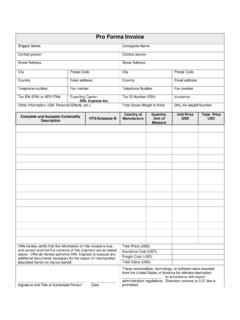Transcription of 510(k) SUBSTANTIAL EQUIVALENCE DETERMINATION DECISION ...
1 1 510(k) SUBSTANTIAL EQUIVALENCE DETERMINATION DECISION SUMMARY ASSAY AND INSTRUMENT COMBINATION TEMPLATE A. 510(k) Number: k133741 B. Purpose for Submission: New device Combining the previously cleared Inform II test strips (k121679; with a modified GDH-PQQ methodology) with the previously cleared performa meter (k070585) C. Measurand: Venous and capillary whole blood glucose from the fingertip D. Type of Test: Quantitative amperometric assay, glucose dehydrogenase (mutant GDH-PQQ) E. Applicant: Roche Diagnostics Corporation F. Proprietary and Established Names: ACCU-CHEK performa Blood Glucose Monitoring System G. Regulatory Information: 1. Regulation section: 21 CFR , Glucose test system 2. Classification: Class II 3. Product code: NBW, System, Test, Blood Glucose, Over the Counter LFR, Glucose Dehydrogenase, Glucose 4.
2 Panel: Clinical Chemistry (75) 2 H. Intended Use: 1. Intended use(s): See Indications for Use below. 2. Indications(s) for use: The ACCU-CHEK performa Blood Glucose Monitoring System is intended to be used for the quantitative measurement of glucose (sugar) in venous whole blood or fresh capillary whole blood from the fingertips. The ACCU-CHEK performa Blood Glucose Monitoring System is intended for testing outside the body (in vitro diagnostic use) and is intended for multiple-patient use in professional healthcare settings as an aid in monitoring the effectiveness of glucose control. This system should only be used with single-use, auto-disabling lancing devices. The ACCU-CHEK performa Blood Glucose Monitoring System should not be used for the diagnosis of or screening for diabetes. This system is also not for neonatal use.
3 The ACCU-CHEK performa test strips are for use with the ACCU-CHEK performa meter to quantitatively measure glucose (sugar) in venous whole blood or fresh capillary blood samples from the fingertips. 3. Special conditions for use statement(s): For in vitro diagnostic use only Not for use in diagnosis or screening of diabetes mellitus Not for neonatal use If peripheral circulation is impaired, collection of capillary blood from the approved sample sites is not advised as the results might not be a true reflection of the physiological blood glucose level. This may apply in the following circumstances: severe dehydration as a result of diabetic ketoacidosis or due to hyperglycemic hyperosmolar non-ketotic syndrome, hypotension, shock, decompensated heart failure NYHA Class IV, or peripheral arterial occlusive disease. The performance of this meter has not been evaluated on critically ill patients.
4 For use with single-use, auto-disabling lancing devices 4. Special instrument requirements: ACCU-CHEK performa Meter I. Device Description: The ACCU-CHEK performa Blood Glucose Monitoring System consists of a the ACCU-CHEK performa meter, ACCU-CHEK performa test strips (sold separately; code key provided in test strip vials), ACCU-CHEK Inform II control solutions (Levels 1 and 2; sold 3 separately), ACCU-CHEK Inform II Linearity Test Kit (6 levels; sold separately), and Operator s Manual. The enzyme on the test strip is a mutant variant of quinoprotein glucose dehydrogenase (Mut. Q-GDH), from Acinetobacter calcoaceticus, recombinant in E. coli. and uses Nitrosoaniline as a mediator. Each box of ACCU-CHEK Inform II control solutions contains one vial ( mL) of each of the 2 buffered aqueous solutions containing D-glucose: Level 1 and Level 2.
5 These control solutions were previously cleared in k121679. The ACCU-CHEK Inform II Linearity Test Kit contains mL of each of the 6 buffered aqueous solutions containing D-glucose: (ACCU-CHEK Linearity 1-6, These linearity solutions were previously cleared in k121679. J. SUBSTANTIAL EQUIVALENCE Information: 1. Predicate device name(s): ACCU-CHEK Inform II Blood Glucose Monitoring System 2. Predicate 510(k) number(s): k121679 3. Comparison with predicate: Similarities Item Predicate (k121679) Candidate Device Brand Name ACCU-CHECK Inform II ACCU-CHEK performa Indications for Use/Intended Use To quantitatively measure glucose (sugar) in whole blood, as an aid in monitoring the effectiveness of glucose control. Same Enzyme Glucose Dehydrogenase PQQ modified by site-directed mutagenesis (Mutant Q-GDH) Same Test Principle Amperometric detection Same Measuring time 5 sec Same Sample volume mL Same Hematocrit range 10-65% Same Altitude claim Up to 10,000 feet Same Coding Lot-specific blood glucose measurement parameters are programmed into code key Same 4 Differences Item Predicate (k121679) Candidate Device Brand Name ACCU-CHECK Inform II ACCU-CHEK performa Measurement range 10-600 mg/dL 20-600 mg/dL Sample Site Venous, arterial, capillary fingerstick and neonate heelstick Venous, and capillary fingerstick Code Key Port Code key inserts into code key reader which transfer data to meter via IR communication Code key inserts directly into code key slot in meter Battery V rechargeable battery pack (lithium technology))
6 One 3-volt lithium type CR2032 coin cell Bar Code Scanner Yes None Transmission of Retrospective Data to External Devices Wirelessly to WLAN through RF communication or to docking station base unit through IR data port None Meter Physical Appearance in x in x in (LWH), lbs in x in x in (LWH), lbs K. Standard/ Guidance Document Referenced (if applicable): ISO 15197: In vitro diagnostic test systems - Requirements for blood-glucose monitoring systems for self-testing in managing diabetes mellitus. CLSI EP5-A2, Evaluation of Precision Performance of Quantitative Measurement Methods; Approved Guideline. CLSI EP7-A2, Interference Testing in Clinical Chemistry; Approved Guideline. L. Test Principle: The test is based on electrochemical biosensor technology and the principle of capillary action. The electrical current generated by the reaction of glucose with the reagent of the strip is measured by the meter and is displayed as the corresponding blood glucose level.
7 The strength of the current produced by the reaction depends on the amount of glucose in the blood sample. M. Performance Characteristics (if/when applicable): 1. Analytical performance: a. Precision/Reproducibility: 5 Repeatability studies were performed with venous whole blood samples at five glucose concentration ranges using 3 test strip lots. Ten runs were performed on each sample with 5 replicates per run/strip lot resulting in a total of 100 replicates collected for each test strip lot and each glucose level tested. Results are summarized below: Glucose Level 30-50 (mg/dL) 50-110 (mg/dL) 110-150 (mg/dL) Test Strip Lot 1 2 3 1 2 3 1 2 3 Mean (mg/dL) SD CV% n 100 100 100 100 100 100 100 100 100 Glucose Level 150-250 (mg/dL) 250-400 (mg/dL) Test Strip Lot 1 2 3 1 2 3 Mean (mg/dL) SD CV% n 100 100 100 100 100 100 Intermediate precision was evaluated using three glucose linearity solutions, Level 2, Level 3, and Level 4.
8 Ten strip vials, from three test strip lots, were assigned to each of the three linearity levels. From each strip vial, a test was performed on each of the 3 linearity level solutions for 10 days. A total of 10 replicates were collected per vial, strip lot, and glucose level tested for a total of 300 measurements per glucose level. Results are summarized below: Glucose Level Level 2 (45 mg/dL) Level 3 (118 mg/dL) Level 4 (307 mg/dL) Test Strip Lot 1 2 3 1 2 3 1 2 3 Mean (mg/dL) SD CV% n 100 100 100 100 100 100 100 100 100 b. Linearity/assay reportable range: Linearity was evaluated using 3 test strip lots and 11 venous blood samples ranging in glucose concentrations from to mg/dL ( , , , , , , 6 , , , , and mg/dL). Three runs were performed on each sample, on each strip lot, with replicates of 8 for each run and test strip lot resulting in a total of 24 replicates for each test strip lot and glucose level tested.
9 The values from the performa meter were compared with those obtained from the reference method. The results from regression analysis are summarized below: Lot #1: y= x+ ; R2 = Lot #2: y= x+ ; R2 = Lot #3: y= x+ ; R2 = The results of the study support the sponsor s claimed glucose measurement range of 20 to 600 mg/dL. c. Traceability, Stability, Expected values (controls, calibrators, or methods): According to the sponsor, the ACCU-CHEK performa system is traceable to the NIST SRM 917 glucose reference material. A method comparison was performed using the candidate device and a hexokinase method (Hitachi 917) as the reference method (see Section ) Value Assignment for Control Solutions and Linearity Set: The previously cleared (k121679) ACCU-CHEK Inform II control solutions (Levels 1 and 2) and 6 levels of the ACCU-CHEK Inform II Linearity Test Kit (Levels 1 to 6) are available for use with the ACCU-CHEK performa test system.
10 The Linearity Solutions levels 2 and 4 are the same as the Control solution levels 1 and 2, respectively. Value assignment for the control solutions and linearity set is established for the ACCU-CHEK performa test system and is based on the mean of repeated measurements compared to the established target values for each level. The target values for the linearity levels are provided in the linearity kit package insert and the control solution ranges are printed on the test strip vial label. Control Solution and Linearity Set Stability: Protocols and acceptance criteria for open vial and closed vial (shelf-life) stability for the control solutions and linearity set solutions were previously reviewed and found to be acceptable under k121679. The labeling claims are 24 month shelf life stability and 3 month open-vial stability when stored at the recommended storage temperatures of 39 F to 86 F (4 C to 30 C).
